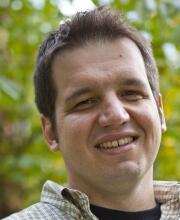Lithium niobate (LN) is an “old” material with many applications in optical and microwave technologies,
owing to its unique properties that include large second order nonlinear susceptibility, large piezoelectric
response, and wide optical transparency window. Conventional discrete LN components, the workhorse of the
optoelectronic industry for many decades, are reaching their limits, however. I will discuss our efforts aimed at
the development of integrated LN photonic platform, featuring strong light confinement and dense integration,
that has the potential to revolutionize optical communication networks and microwave photonic systems, as
well as enable realization of quantum photonic circuits. Examples include high bandwidth, low voltage, and low
loss electro-optic (EO) modulators [1], EO frequency combs [2], and programmable “photonic molecules” [3].
Devices that benefit from LN’s strong second and third order nonlinearity, including second harmonic generators
[4] and Kerr frequency combs [5] will also be discussed.
1. C. Wang, M. Zhang, X. Chen, M. Bertrand, A. Shams-Ansari, S. Chandrasekhar, P. Winzer, and M.
Lončar. “Integrated lithium niobate electro-optic modulators operating at CMOS-compatible voltages.” Nature,
562, 101 (2018)
2. M. Zhang, B. Buscaino, C. Wang, A. Shams-Ansari, C. Reimer, R. Zhu, J. Kahn, and M. Loncar. “Broadband
electro-optic frequency comb generation in an integrated microring resonator.” Nature, 568, 373(2019)
3. M. Zhang, C. Wang, Y. Hu, A. Shams-Ansari, T. Ren, S. Fan, and M. Lončar. “Electronically Programmable
Photonic Molecule.” Nature Photonics, 13, 36 (2019)
4. C. Wang, C. Langrock, A. Marandi, M. Jankowski, M. Zhang, B. Desiatov, M. M. Fejer, and M. Lončar.
“Ultrahigh-efficiency wavelength conversion in nanophotonic periodically poled lithium niobate waveguides.”
Optica, 5, 1438 (2018)
5. C. Wang, M. Zhang, M. Yu, R. Zhu, H. Hu, and M. Loncar, “Monolithic lithium niobate photonic circuits for
Kerr frequency comb generation and modulation.” Nature Communications, 10, 978 (2019)

Marko Loncar is Tiantsai Lin Professor of Electrical Engineering at Harvard's John A Paulson School of Engineering
and Applied Sciences (SEAS), as well as Harvard College Professor. Loncar received his Diploma from University of Belgrade (R. Serbia) in 1997, and his PhD from Caltech in 2003 (with Axel Scherer), both in Electrical Engineering. After
completing his postdoctoral studies at Harvard (with Federico Capasso), he joined SEAS faculty in 2006. Loncar is expert
in nanophotonics and nanofabrication, and his current research interests include quantum and nonlinear nanophotonics,
quantum optomechanics, and nanofabrication. He has received NSF CAREER Award in 2009 and Sloan Fellowship in
2010. In recognition of his teaching activities, Loncar has been awarded Levenson Prize for Excellence in Undergraduate
Teaching (2012), and has been named Harvard College Professor in 2017. Loncar is fellow of Optical Society of America,
and Senior Member of IEEE and SPIE. Loncar is co-founder of HyperLight Corporation, a VC backed startup commercializing
lithium niobate photonic technologies.

